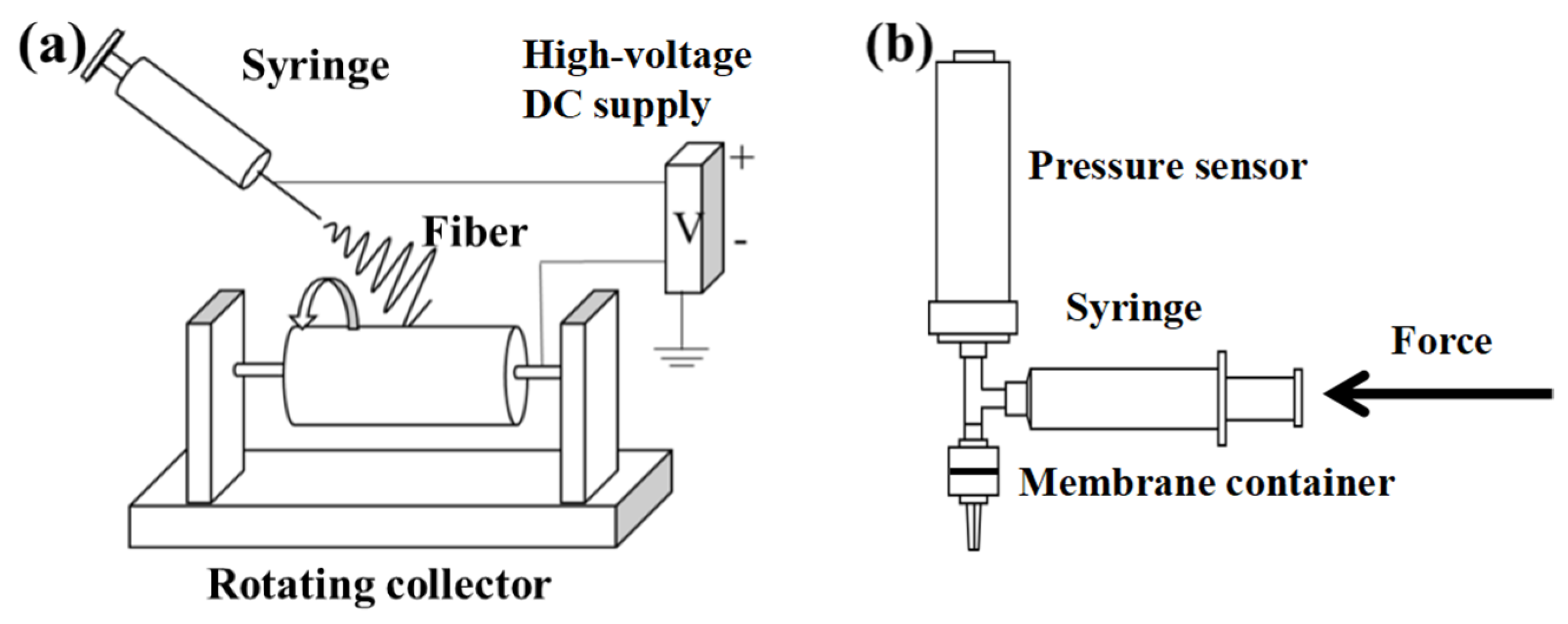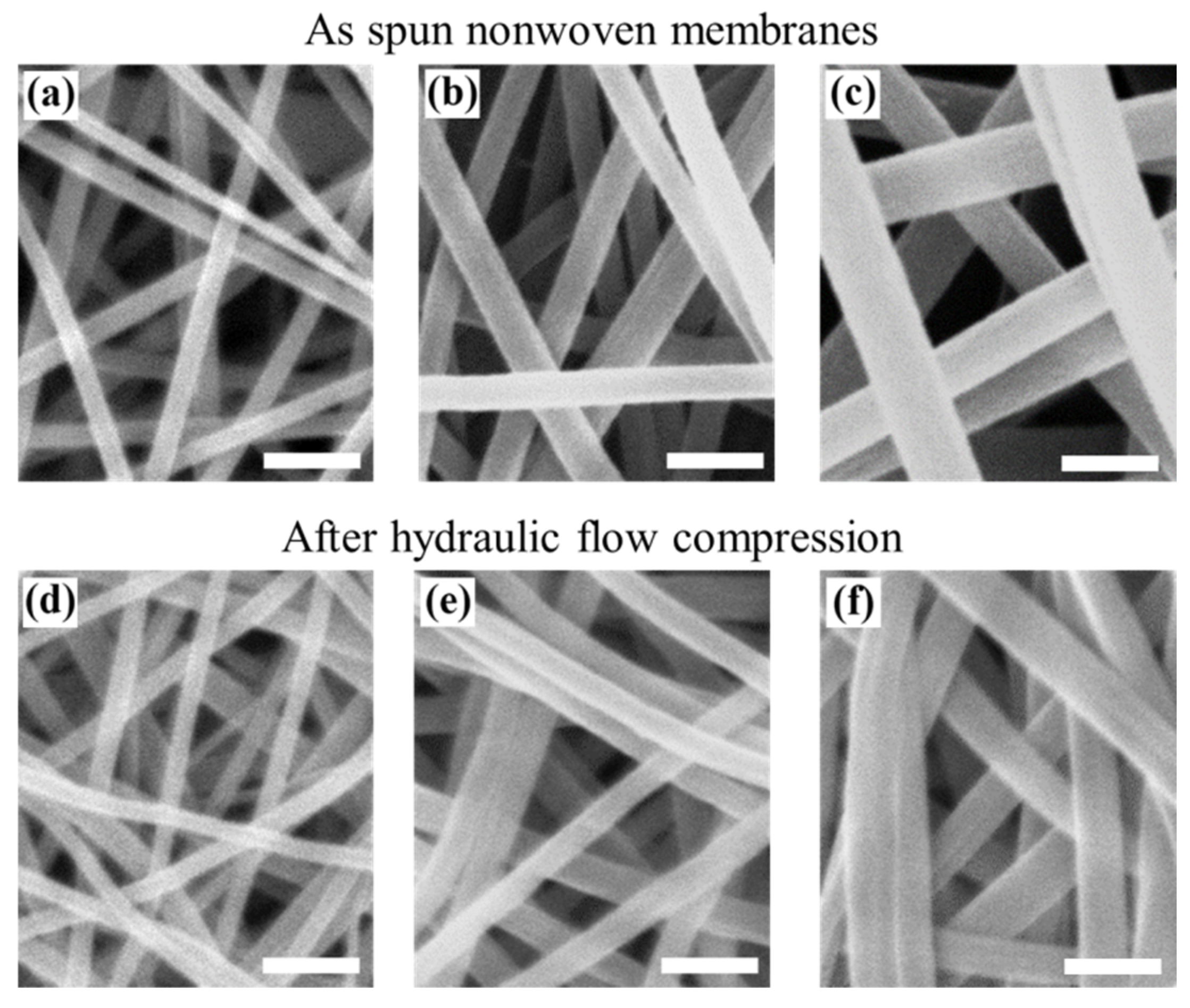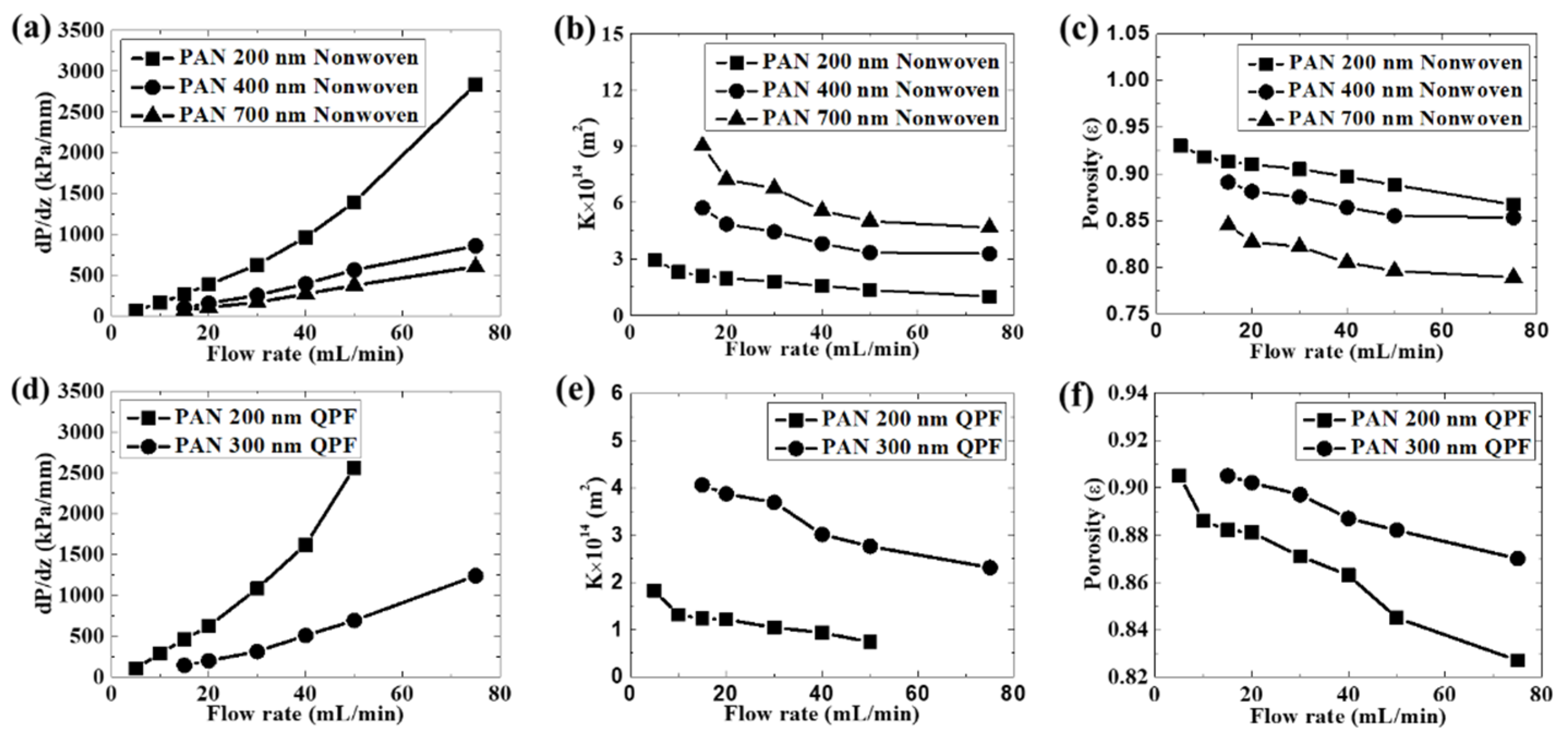An Investigation into Hydraulic Permeability of Fibrous Membranes with Nonwoven Random and Quasi-Parallel Structures
Abstract
:1. Introduction
2. Experimental
2.1. Materials
2.2. Electrospinning
2.3. Characterization
2.3.1. Morphology
2.3.2. Porosity and Fiber Diameter
2.3.3. Fiber Orientation
2.3.4. Membrane Thickness
2.4. Hydraulic Permeability and Deformation Test
3. Results and Discussion
3.1. Morphology
3.2. Hydraulic Permeability
3.3. Deformation
4. Conclusions
Supplementary Materials
Author Contributions
Funding
Institutional Review Board Statement
Data Availability Statement
Conflicts of Interest
References
- Gopal, R.; Kaur, S.; Ma, Z.; Chan, C.; Ramakrishna, S.; Matsuura, T. Electrospun nanofibrous filtration membrane. J. Membr. Sci. 2006, 281, 581–586. [Google Scholar] [CrossRef]
- Yun, K.M.; Hogan, C.J.; Matsubayashi, Y.; Kawabe, M.; Iskandar, F.; Okuyama, K. Nanoparticle filtration by electrospun polymer fibers. Chem. Eng. Sci. 2007, 62, 4751–4759. [Google Scholar] [CrossRef]
- Homaeigohar, S.; Buhr, K.; Ebert, K. Polyethersulfone electrospun nanofibrous composite membrane for liquid filtration. J. Membr. Sci. 2010, 365, 68–77. [Google Scholar] [CrossRef] [Green Version]
- Hajra, M.; Mehta, K.; Chase, G. Effects of humidity, temperature, and nanofibers on drop coalescence in glass fiber media. Sep. Purif. Technol. 2003, 30, 79–88. [Google Scholar] [CrossRef]
- Qin, X.-H.; Wang, S.-Y. Filtration properties of electrospinning nanofibers. J. Appl. Polym. Sci. 2006, 102, 1285–1290. [Google Scholar] [CrossRef]
- Bhardwaj, N.; Kundu, S.C. Electrospinning: A fascinating fiber fabrication technique. Biotechnol. Adv. 2010, 28, 325–347. [Google Scholar] [CrossRef]
- Burger, C.; Hsiao, B.S.; Chu, B. Nanofibrous materials and their applications. Annu. Rev. Mater. Res. 2006, 36, 333–368. [Google Scholar] [CrossRef]
- Yoon, K.; Hsiao, B.S.; Chu, B. Functional nanofibers for environmental applications. J. Mater. Chem. 2008, 18, 5326–5334. [Google Scholar] [CrossRef]
- Choong, L.T.; Mannarino, M.M.; Basu, S.; Rutledge, G.C. Compressibility of electrospun fiber mats. J. Mater. Sci. 2013, 48, 7827–7836. [Google Scholar] [CrossRef] [Green Version]
- Van Wyk, C.M. A study of the compressibility of wool, with special reference to South African merino wool. Onderstepoort J. Vet. Sci. Anim. Ind. 1946, 21, 99–226. [Google Scholar]
- Carnaby, G.A.; Pan, N. Theory of the Compression Hysteresis of Fibrous Assemblies. Text. Res. J. 1989, 59, 275–284. [Google Scholar] [CrossRef]
- Pan, N. A Modified Analysis of the Microstructural Characteristics of General Fiber Assemblies. Text. Res. J. 1993, 63, 336–345. [Google Scholar] [CrossRef]
- Komori, T.; Itoh, M. Theory of the General Deformation of Fiber Assemblies. Text. Res. J. 1991, 61, 588–594. [Google Scholar] [CrossRef]
- Komori, T.; Itoh, M. A Modified Theory of Fiber Contact in General Fiber Assemblies. Text. Res. J. 1994, 64, 519–528. [Google Scholar] [CrossRef]
- Toll, S. Packing mechanics of fiber reinforcements. Polym. Eng. Sci. 1998, 38, 1337–1350. [Google Scholar] [CrossRef]
- Baudequin, M.; Ryschenkow, G.; Roux, S. Non-linear elastic behavior of light fibrous materials. Eur. Phys. J. B 1999, 12, 157–162. [Google Scholar] [CrossRef]
- Jönsson, K.A.-S.; Jönsson, B.T.L. Fluid flow in compressible porous media: I: Steady-state conditions. AIChE J. 1992, 38, 1340–1348. [Google Scholar] [CrossRef]
- Jackson, G.W.; James, D.F. The permeability of fibrous porous media. Can. J. Chem. Eng. 1986, 64, 364–374. [Google Scholar] [CrossRef]
- Happel, J. Viscous flow relative to arrays of cylinders. AIChE J. 1959, 5, 174–177. [Google Scholar] [CrossRef]
- Drummond, J.; Tahir, M. Laminar viscous flow through regular arrays of parallel solid cylinders. Int. J. Multiph. Flow 1984, 10, 515–540. [Google Scholar] [CrossRef]
- Tamayol, A.; Bahrami, M. Transverse permeability of fibrous porous media. Phys. Rev. E 2011, 83, 046314. [Google Scholar] [CrossRef] [Green Version]
- Mao, N.; Russell, S.J. Directional Permeability in Homogeneous Nonwoven Structures Part I: The Relationship between Directional Permeability and Fibre Orientation. J. Text. Inst. 2000, 91, 235–243. [Google Scholar] [CrossRef]
- Mao, N.; Russell, S. Modeling Permeability in Homogeneous Three-Dimensional Nonwoven Fabrics. Text. Res. J. 2003, 73, 939–944. [Google Scholar] [CrossRef]
- Clague, D.S.; Phillips, R.J. A numerical calculation of the hydraulic permeability of three-dimensional disordered fibrous media. Phys. Fluids 1997, 9, 1562–1572. [Google Scholar] [CrossRef]
- Davies, V.C.N. Air Filtration; Academic Press: London, UK; New York, NY, USA, 1973. [Google Scholar]
- Choong, L.T. (Simon); Khan, Z.; Rutledge, G.C. Permeability of electrospun fiber mats under hydraulic flow. J. Membr. Sci. 2014, 451, 111–116. [Google Scholar] [CrossRef] [Green Version]
- Liang, M.; Liu, Y.; Xiao, B.; Yang, S.; Wang, Z.; Han, H. An analytical model for the transverse permeability of gas diffusion layer with electrical double layer effects in proton exchange membrane fuel cells. Int. J. Hydrogen Energy 2018, 43, 17880–17888. [Google Scholar] [CrossRef]
- Xiao, B.; Wang, W.; Zhang, X.; Long, G.; Fan, J.; Chen, H.; Deng, L. A novel fractal solution for permeability and Kozeny-Carman constant of fibrous porous media made up of solid particles and porous fibers. Powder Technol. 2019, 349, 92–98. [Google Scholar] [CrossRef]
- Xiao, T.; Guo, J.; Yang, X.; Hooman, K.; Lu, T.J. On the modelling of heat and fluid transport in fibrous porous media: Analytical fractal models for permeability and thermal conductivity. Int. J. Therm. Sci. 2022, 172, 107270. [Google Scholar] [CrossRef]
- Woudberg, S.; Theron, F.; Lys, E.; LE Coq, L. Investigating the influence of local porosity variations and anisotropy effects on the permeability of fibrous media for air filtration. Chem. Eng. Sci. 2018, 180, 70–78. [Google Scholar] [CrossRef]
- Cai, J.; Liu, X.; Zhao, Y.; Guo, F. Membrane desalination using surface fluorination treated electrospun polyacrylonitrile membranes with nonwoven structure and quasi-parallel fibrous structure. Desalination 2018, 429, 70–75. [Google Scholar] [CrossRef]
- Shaulsky, E.; Nejati, S.; Boo, C.; Perreault, F.; Osuji, C.O.; Elimelech, M. Post-fabrication modification of electrospun nanofiber mats with polymer coating for membrane distillation applications. J. Membr. Sci. 2017, 530, 158–165. [Google Scholar] [CrossRef] [Green Version]
- Fisher, N.I. Statistical Analysis of Circular Data; Cambridge University Press: Cambridge, UK; New York, NY, USA, 1993. [Google Scholar]






| Rotating Speed (rpm) | Structure | Flow Rate (mL/min) | Polyacrylonitrile (PAN) Concentration (%) | Fiber Diameter (nm) | Thickness (μm) |
|---|---|---|---|---|---|
| 40 | Nonwoven Random | 0.02 | 11.5 14 16 | 200 400 700 | 86 71 96 |
| 2800 | Quasi Parallel | 0.015 | 11.5 14 16 | 200 300 350 | 87 72 40 |
Publisher’s Note: MDPI stays neutral with regard to jurisdictional claims in published maps and institutional affiliations. |
© 2021 by the authors. Licensee MDPI, Basel, Switzerland. This article is an open access article distributed under the terms and conditions of the Creative Commons Attribution (CC BY) license (https://creativecommons.org/licenses/by/4.0/).
Share and Cite
Liu, Z.; Wang, Y.; Guo, F. An Investigation into Hydraulic Permeability of Fibrous Membranes with Nonwoven Random and Quasi-Parallel Structures. Membranes 2022, 12, 54. https://doi.org/10.3390/membranes12010054
Liu Z, Wang Y, Guo F. An Investigation into Hydraulic Permeability of Fibrous Membranes with Nonwoven Random and Quasi-Parallel Structures. Membranes. 2022; 12(1):54. https://doi.org/10.3390/membranes12010054
Chicago/Turabian StyleLiu, Zeman, Yiqi Wang, and Fei Guo. 2022. "An Investigation into Hydraulic Permeability of Fibrous Membranes with Nonwoven Random and Quasi-Parallel Structures" Membranes 12, no. 1: 54. https://doi.org/10.3390/membranes12010054
APA StyleLiu, Z., Wang, Y., & Guo, F. (2022). An Investigation into Hydraulic Permeability of Fibrous Membranes with Nonwoven Random and Quasi-Parallel Structures. Membranes, 12(1), 54. https://doi.org/10.3390/membranes12010054








